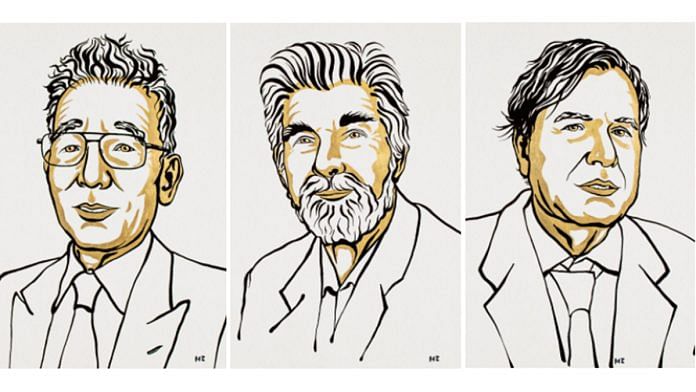Bengaluru: The 2021 Nobel Prize in Physics has been awarded jointly to three scientists — Syukuro Manabe of Princeton University, Klaus Hasselmann of Max Planck Institute of Meteorology, and Giorgio Parisi of Sapienza University of Rome.
The combined work of the three laureates has contributed to humanity’s understanding of the effects of carbon dioxide emissions into the atmosphere, the accelerating greenhouse effect, and cyclical patterns in natural phenomena (starling murmurations) and long-term climate phenomena (recurring ice ages).
The prize amount of 10 million Swedish kronor (approx. Rs 8.3 crore) is to be split in half, with one part going jointly to Manabe and Hasselmann for their work on the Earth’s climate and humanity’s influence on it, and the other to Parisi for his work on random processes and disordered materials.
“Complex systems are characterised by randomness and disorder and are difficult to understand. This year’s Prize recognises new methods for describing them and predicting their long-term behaviour,” said the Nobel Committee in its official release Tuesday.
The statement from Thors Hans Hansson, chair of the Nobel Committee for Physics, added: “The discoveries being recognised this year demonstrate that our knowledge about the climate rests on a solid scientific foundation, based on a rigorous analysis of observations. This year’s Laureates have all contributed to us gaining deeper insight into the properties and evolution of complex physical systems.”
Also read: How we feel temperature and touch: Research that won US scientists Nobel Prize in medicine
Complex systems and Earth’s climate
The Earth’s climate is considered to be a complex physical system, characterised by many parameters that influence each other and create random, chaotic processes that are difficult to model mathematically. In such models, extremely minor deviations and modifications result in exponentially large differences at a later point in time.
Understanding these parameters in a warming world requires comprehending the influence of human activity on the environment and the climate.
In the 1960s, Manabe was one of the earliest scientists to develop physical models of the Earth’s climate. He was the first person to study how the balance between radiation received by Earth from the Sun and radiated back to space from Earth (radiation balance), affects the vertical movement of air. He discovered that oxygen and nitrogen had negligible effects on surface temperature while carbon dioxide increased temperatures.
Manabe’s work paved the way for the development of the very first climate models in the world to explore humanity’s role in carbon dioxide emissions.
Hasselmann performed pioneering work in early climate models that came to be developed in the 1970s, and established that despite complex, chaotic processes, climate models are reliable. He created the first model to link weather in the short term to climate in the long term. He also created the first methods to identify the human fingerprints on climate, and changes stemming from natural phenomena not influenced by humans such as solar radiation, the Milankovitch cycles, and volcanic emissions.
Hasselmann’s work proved that anthropogenic emissions of carbon dioxide are the cause for rising atmospheric temperatures today.
In the 1980s, Parisi performed work on disordered complex materials. These are materials that, at atomic and molecular levels, are not homogenous and have minute structural or magnetic differences throughout their form.
There are two main classes of disordered materials — liquids and different kinds of glass.
Parisi identified hidden patterns in glass which explained seemingly random and chaotic processes, and his work influenced the understanding of random processes and complex materials in other subjects as well, such as biology, neuroscience, machine learning, and mathematics.
The Physics Nobel’s India connection
The Nobel Prizes are awarded every year in the subjects of physiology or medicine, physics, chemistry, literature, and peace. A sixth Nobel Memorial Prize in Economic Sciences, not established in Alfred Nobel’s will in 1895, is also awarded by the Karolinska Institutet. Winners are selected by committees in Sweden and Norway, and receive a gold medal and 10 million Swedish kronor (Rs 8.3 crore).
The Nobel prizes have also been a subject of ongoing criticism for their lack of recognition of women, people of colour, and scientists from the global south or middle and low income countries. Of the 219 laureates of the Nobel in Physics since 1901, only four have been women. In total, only 14 have not been citizens of the United States, EU, or the former Soviet Union.
Two Indian-origin scientists have received the Physics Nobel — C.V. Raman was the 1930 laureate for his work on the scattering of light (Raman effect), while Indian-American Subrahmanyan Chandrasekhar won the 1983 Physics Nobel for stellar evolution.
Mohammad Abdus Salam from Pakistan won it in 1979 for his work on electromagnetic interaction.
Also read: Women pioneers to be focus as World Space Week kicks off today






